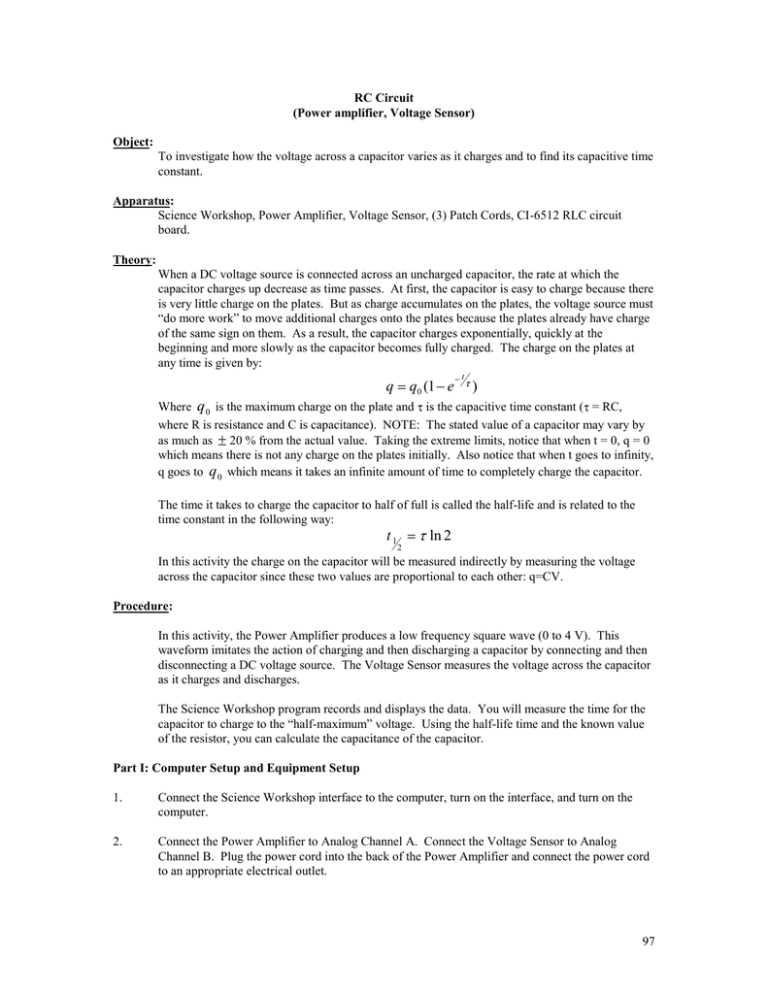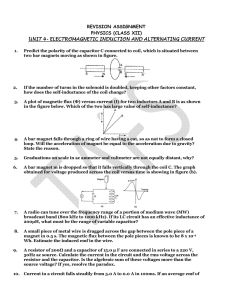q q e ) t1 2ln
advertisement

RC Circuit (Power amplifier, Voltage Sensor) Object: To investigate how the voltage across a capacitor varies as it charges and to find its capacitive time constant. Apparatus: Science Workshop, Power Amplifier, Voltage Sensor, (3) Patch Cords, CI-6512 RLC circuit board. Theory: When a DC voltage source is connected across an uncharged capacitor, the rate at which the capacitor charges up decrease as time passes. At first, the capacitor is easy to charge because there is very little charge on the plates. But as charge accumulates on the plates, the voltage source must “do more work” to move additional charges onto the plates because the plates already have charge of the same sign on them. As a result, the capacitor charges exponentially, quickly at the beginning and more slowly as the capacitor becomes fully charged. The charge on the plates at any time is given by: q q0 (1 e t ) Where q 0 is the maximum charge on the plate and is the capacitive time constant ( = RC, where R is resistance and C is capacitance). NOTE: The stated value of a capacitor may vary by as much as 20 % from the actual value. Taking the extreme limits, notice that when t = 0, q = 0 which means there is not any charge on the plates initially. Also notice that when t goes to infinity, q goes to q 0 which means it takes an infinite amount of time to completely charge the capacitor. The time it takes to charge the capacitor to half of full is called the half-life and is related to the time constant in the following way: t1 ln 2 2 In this activity the charge on the capacitor will be measured indirectly by measuring the voltage across the capacitor since these two values are proportional to each other: q=CV. Procedure: In this activity, the Power Amplifier produces a low frequency square wave (0 to 4 V). This waveform imitates the action of charging and then discharging a capacitor by connecting and then disconnecting a DC voltage source. The Voltage Sensor measures the voltage across the capacitor as it charges and discharges. The Science Workshop program records and displays the data. You will measure the time for the capacitor to charge to the “half-maximum” voltage. Using the half-life time and the known value of the resistor, you can calculate the capacitance of the capacitor. Part I: Computer Setup and Equipment Setup 1. Connect the Science Workshop interface to the computer, turn on the interface, and turn on the computer. 2. Connect the Power Amplifier to Analog Channel A. Connect the Voltage Sensor to Analog Channel B. Plug the power cord into the back of the Power Amplifier and connect the power cord to an appropriate electrical outlet. 97 3. Open the Science Workshop document titled as shown below: Windows: P43_RCCI.SWS 4. The Sampling settings for this activity are: Periodic Samples = Fast at 1000 Hz and Stop Condition = Time at 4.00 seconds. 5. The Signal Generator is set to output a 4.00 V, “positive only” square AC Waveform, at 0.40 Hz. It is set to Auto so the Signal Generator will start automatically when you click “start” and stop automatically. 6. Connect a jumper cable to remove the inductor from the circuit. 7. Connect the positive output from the Power Amplifier to the jack just below the 100 resistor. 8. Connect the negative output from the Power Amplifier to the jack just below the 330 capacitor. f The circuit now consists of a 100 9. resistor in series with a 330 Connect the voltage sensor across the 330 f capacitor. f capacitor as shown below. Part II: Data Recording 1. 2. Turn on the power switch on the back of the Power Amplifier. The Signal Generator output will automatically start when data recording begins. 3. Data recording will continue for four seconds and then stop automatically. 4. When data taking is complete, turn off the switch on the back of the Power Amplifier. Analyzing The Data: 1. 98 Click the Autoscale button ( ) in the Graph to rescale the Graph to fit the data. 2. Click the Magnifier button ( ). Use the cursor to click-and-draw a rectangle over a region of the plot of Voltage versus Time that shows the voltage rising from zero volts to the maximum volts. * This will give you an expanded view of the Voltage versus Time plot for that region. 3. Click the Smart Cursor button ( ). The cursor changes to a cross-hair when you move the cursor into the display area of the Graph. * The Y-coordinate of the cursor/cross-hair is shown next to the vertical axis. * The X-coordinate of the cursor/cross-hair is shown next to the horizontal axis. 99 4. Move the cursor to the point on the plot where the voltage begins to rise. Record the time that is shown in the area below the horizontal axis. 5. Move the Smart Cursor to the point where the voltage is approximately 2.00 volts. Record the new time that is shown in the area below the horizontal axis. 6. Find the difference between the two times and record it as the time to “half-max”, or t 1 2 . Data: Beginning time = ___________ s Time to 2.00 V = ___________ s Time to half-max ( t 1 2 ) = ____________ s 1. Use t 1 2 = ln 2 = 0.693RC to calculate the capacitance (C) of the capacitor. Capacitance = _____________ farad 2. If a capacitance meter is available, use it to measure the capacitance of the capacitor. Using the percent difference method, compare the measured value to the experimental value. (Remember, the stated value of a capacitor may vary by as much as 20% from the actual measured value.) If a capacitance meter is not available, use the percent difference method and compare the stated value (e.g., 330 F) to the experimental value. Questions: 100 1. The time to half-maximum voltage is how long it takes the capacitor to charge halfway. Based on your experimental results, how long does it take for the capacitor to charge to 75% of its maximum? 2. After four “half-lives” (i.e., time to half-max), to what percentage of the maximum charge is the capacitor charged? 3. What is the maximum charge for the capacitor in this experiment? 4. What are some factors that could account for the percent difference between the stated and experimental values? 101 Induction-Magnet through a coil (Photogate, Voltage Sensor) Object: Measure the electromotive force (emf) induced in a coil by a moving magnet. Apparatus: Science Workshop Interface, Voltage Sensor, Photogate, RLC circuit board, two Alnico magnets Theory: When a magnet is passed through a coil there is a changing magnetic flux through the coil. This changing flux induces an electromotive force (emf) in the coil. According to Faraday’s law of induction: N t Where is the induced emf , N is the number of turns of wire in the coil, and t is the rate of change of flux through the coil. In this experiment you will plot emf vs. time and find the area beneath the curve. The area represents the flux through the coil since: t = -N Procedure: In this lab, a voltage sensor measures the voltage (V) induced in a coil as a magnet falls through the coil. Data collection begins when the falling magnet breaks the beam of the photogate. The science workshop program records and displays the induced voltage as a function of time, and integrates the area under the curve of voltage vs. time. Part I: Computer Setup 1. Connect the Science Workshop interface to the computer, turn on the interface, and turn on the computer. 2. Connect the voltage sensor DIN plug into Analog Channel A. 3. Connect the photogate stereo phone plug into digital channel 1. 4. Open the Science Workshop document titled: P41_INDU.SWS 5. The instrument opens displaying a graph of voltage vs. time as well as a meter display of voltage. 6. Check that your Sampling options are set as: Periodic sample = fast at 200 Hz, Start condition = Ch1, low (blocked), and stop condition= Time at 0.5 seconds. 102 Part II: Sensor Calibration and Equipment Setup 1. No calibration is required. Attach banana plugs to the terminals of the voltage sensor. 2. Attach the other end of the banana plugs across the coil in the LCR circuit board. To interface (Channel 1) To interface (Channel A) 3. Arrange the circuit board so that the coil hangs over the edge of the lab table or is balanced on an empty cup. The dropped magnet must pass freely and completely through the coil. 4. Turn the photogate head so that it is horizontal. Position the photogate above the coil so that the falling magnet will break the beam. 5. The magnet will be dropped through the coil. Make sure to catch the magnet so that it does not hit the floor. 103 Part III: Data Recording 1. Hold the magnet so that the south end is about 2cm above the photogate. The south end is designated by the narrow groove near the end. 2. Click the “Start” button and drop the magnet through the photogate head and the coil 3. Data recording will begin when the magnet breaks the beam of the photogate. Recording will end automatically after 0.5 seconds. 5. Run #1 will appear in the data list in the experimental setup window. Analyzing the Data: 1. Click the graph to make it active. 2. Click the statistics button to open the statistics area on the right hand side of the graph. Click on the Autoscale button to rescale the graph to fit the data. In the statistics panel click statistics menu button. Select integration from the menu. 3. In the graph display, use the cursor to click and draw a rectangle around the first peak of the plot. The area under the curve for the first will appear in the statistics area. 4. Record the value of the integration for the first peak. Integration first peak = _________ (VoltSec) 5. Repeat the process to find the area under the second peak. Record the value. Integration second peak = _________ (VoltSec) 104 Questions: 1. Is the incoming flux equal to the outgoing flux? 2. Why does the outgoing peak (the second peak) have a greater magnitude than the incoming peak? 3. Why are the peaks in opposite directions? For fun: 1. Tape two magnets together so both south ends are together. 2. Tape two magnets together such that south end and north ends are together. 105


